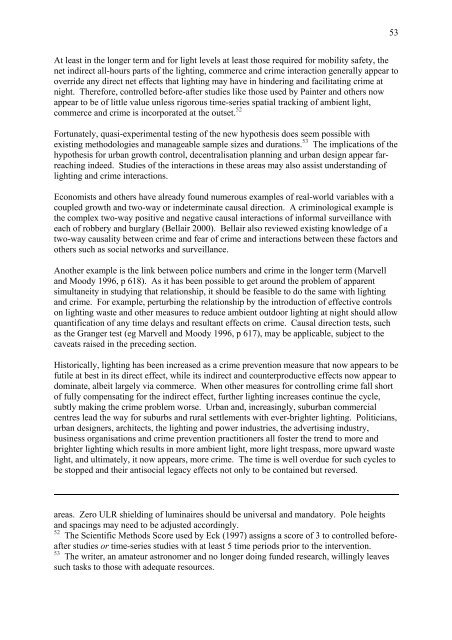Outdoor Lighting and Crime - Amper
Outdoor Lighting and Crime - Amper
Outdoor Lighting and Crime - Amper
You also want an ePaper? Increase the reach of your titles
YUMPU automatically turns print PDFs into web optimized ePapers that Google loves.
At least in the longer term <strong>and</strong> for light levels at least those required for mobility safety, the<br />
net indirect all-hours parts of the lighting, commerce <strong>and</strong> crime interaction generally appear to<br />
override any direct net effects that lighting may have in hindering <strong>and</strong> facilitating crime at<br />
night. Therefore, controlled before-after studies like those used by Painter <strong>and</strong> others now<br />
appear to be of little value unless rigorous time-series spatial tracking of ambient light,<br />
commerce <strong>and</strong> crime is incorporated at the outset. 52<br />
Fortunately, quasi-experimental testing of the new hypothesis does seem possible with<br />
existing methodologies <strong>and</strong> manageable sample sizes <strong>and</strong> durations. 53 The implications of the<br />
hypothesis for urban growth control, decentralisation planning <strong>and</strong> urban design appear farreaching<br />
indeed. Studies of the interactions in these areas may also assist underst<strong>and</strong>ing of<br />
lighting <strong>and</strong> crime interactions.<br />
Economists <strong>and</strong> others have already found numerous examples of real-world variables with a<br />
coupled growth <strong>and</strong> two-way or indeterminate causal direction. A criminological example is<br />
the complex two-way positive <strong>and</strong> negative causal interactions of informal surveillance with<br />
each of robbery <strong>and</strong> burglary (Bellair 2000). Bellair also reviewed existing knowledge of a<br />
two-way causality between crime <strong>and</strong> fear of crime <strong>and</strong> interactions between these factors <strong>and</strong><br />
others such as social networks <strong>and</strong> surveillance.<br />
Another example is the link between police numbers <strong>and</strong> crime in the longer term (Marvell<br />
<strong>and</strong> Moody 1996, p 618). As it has been possible to get around the problem of apparent<br />
simultaneity in studying that relationship, it should be feasible to do the same with lighting<br />
<strong>and</strong> crime. For example, perturbing the relationship by the introduction of effective controls<br />
on lighting waste <strong>and</strong> other measures to reduce ambient outdoor lighting at night should allow<br />
quantification of any time delays <strong>and</strong> resultant effects on crime. Causal direction tests, such<br />
as the Granger test (eg Marvell <strong>and</strong> Moody 1996, p 617), may be applicable, subject to the<br />
caveats raised in the preceding section.<br />
Historically, lighting has been increased as a crime prevention measure that now appears to be<br />
futile at best in its direct effect, while its indirect <strong>and</strong> counterproductive effects now appear to<br />
dominate, albeit largely via commerce. When other measures for controlling crime fall short<br />
of fully compensating for the indirect effect, further lighting increases continue the cycle,<br />
subtly making the crime problem worse. Urban <strong>and</strong>, increasingly, suburban commercial<br />
centres lead the way for suburbs <strong>and</strong> rural settlements with ever-brighter lighting. Politicians,<br />
urban designers, architects, the lighting <strong>and</strong> power industries, the advertising industry,<br />
business organisations <strong>and</strong> crime prevention practitioners all foster the trend to more <strong>and</strong><br />
brighter lighting which results in more ambient light, more light trespass, more upward waste<br />
light, <strong>and</strong> ultimately, it now appears, more crime. The time is well overdue for such cycles to<br />
be stopped <strong>and</strong> their antisocial legacy effects not only to be contained but reversed.<br />
areas. Zero ULR shielding of luminaires should be universal <strong>and</strong> m<strong>and</strong>atory. Pole heights<br />
<strong>and</strong> spacings may need to be adjusted accordingly.<br />
52 The Scientific Methods Score used by Eck (1997) assigns a score of 3 to controlled beforeafter<br />
studies or time-series studies with at least 5 time periods prior to the intervention.<br />
53 The writer, an amateur astronomer <strong>and</strong> no longer doing funded research, willingly leaves<br />
such tasks to those with adequate resources.<br />
53
















